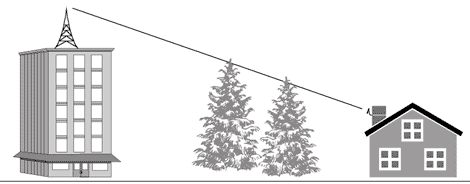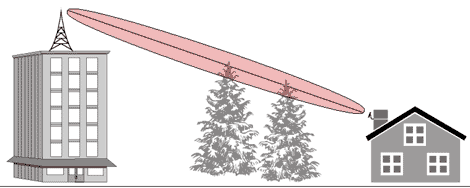|
 |
 What about line of Site?
What about line of Site? |
The technology and frequencies used by Rapid WiFi's wireless antennas
requires a clear path between antennas. This is called Radio Line of Sight,
or LOS. |
 |
|
|
Line of sight is the direct free-space path that exists between two points.
Using binoculars on a clear day, it is easy to determine if visual line of
sight exists between two points that are miles apart. To have a clear line
of sight there must be no obstructions between the two locations. Often this
means that the observation points must be high enough to allow the viewer to
see over any ground-based obstructions.
The following obstructions might obscure a visual link:
Topographic features, such as hills or mountains
The curvature of the Earth
Buildings and other man-made objects
Trees and other vegitation
If any of these obstructions rise high enough to block the view from end to
end, there is no visual line of sight.

Obstructions that can interfere with visual line of sight can also interfere
with radio line of sight. But one must also consider the Fresnel effect. If
an object, such as a building, hill or tree, is too close to the signal
path, it can damage the radio signal or reduce its strength. This happens
even though the obstacle does not obscure the direct, visual line of
sight.
The Fresnel zone for a radio beam is an elliptical area immediately
surrounding the visual path. It varies in thickness depending on the length
of the signal path and the frequency of the signal. The necessary clearance
for the Fresnel zone can be calculated, and it must be taken into account
when designing wireless links.

As shown in the picture above, when an object protrudes into the signal path
within the Fresnel zone, knife-edge diffraction can deflect part of the
signal and cause it to reach the receiving antenna slightly later than the
direct signal. Since these deflected signals are out of phase with the
direct signal, they can reduce its power or cancel it out altogether. If
trees or other 'soft' objects protrude into the Fresnel zone, they can
attenuate (reduced the strength of) a passing signal. In short, the fact
that you can see a location does not mean that you can establish a quality
radio link to that location.
For short links of two miles or less, you can determine radio line of sight
by climbing to the proposed antenna mounting point and looking for the other
site with the aid of binoculars. If you can see the destination point, you
can calculate the Fresnel zone allowance by consulting a reference table, or
using the calculator below. If any obstacles (buildings, trees, etc.) in the
Fresnel zone between the two points could interfere with the signal, the
calculation for the antenna height must take these obstructions into
account.
Rapid WiFi uses computerized maps provided by the US Geological Service to
make a preliminary assessment concerning the feasibility of a radio link
between two points. Where the preliminary finding leaves any doubt, it is
the customer's responsibility to engage the proper resources to certify that
radio line of sight for the desired frequency is possible and what the
antenna heights must be. You may also request a free site survey to
determine if a radio link is possible.
There are several options to establish or improve the line of sight:
Raise the antenna mounting point on the existing structure
Erect a radio tower tall enough to mount the antenna
Increase the height of an existing tower
Change the mounting point for the antenna, i.e. building or tower
Cut down or top problem trees
For more information and pricing on this innovative and
exciting new service, please feel free to . |
|
|